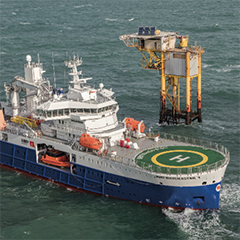After many years of renewables being somewhat the ‘Cinderella’ of the energy industry, it is fascinating to see that it is now offshore wind power driving innovation and its smart solutions are being taken up by the well-established oil and gas sector.
A good example was highlighted recently when Damen’s first Service Operations Vessel (SOV), which was purpose-built for the offshore wind market, entered the oil and gas business on a three-year contract.
The SOV – with Walk-to-Work capability – is dedicated to the transfer and accommodation of offshore personnel but its design was essentially developed from the requirements of the North Sea offshore wind market. The first vessel, Bibby WaveMaster 1, owned by Bibby Marine Services Ltd, was introduced to the market in 2017 and she headed straight to the offshore wind market in the southern North Sea.
However, less than a year later, Bibby WaveMaster 1 will begin a major contract for Total E&P Nederland. Bibby Marine Services announced that Total E&P Nederland will charter the vessel to access gas platforms in the North Sea from April to October this year, but this has now been extended to three years.
Three-year contract for Bibby WaveMaster 1
Although there are many synergies between both offshore industries, Bibby WaveMaster 1 is largely a result of the push for reducing the total cost of wind energy to enable the industry to be less reliant on subsidies.
The vessel underwent rigorous model testing and simulator tests at MARIN in the Netherlands. The gangway motion, vessel hull shape dynamics and the DP system and how these individual components interact with each other, were considered. This is crucial to the design and gives the required ‘certainty of access’ to offshore structures in severe weather conditions.
A key factor in Bibby WaveMaster 1 is the unique, multi-stop elevator. This is linked to the gangway, so a technician can go from the warehouses or deck level straight upwards on the elevator, over the gangway and directly onto the turbine Transition Piece, without climbing a step.
The first subsidy-free wind farms are now a reality and this has been brought about over the years of improving operations offshore and through cost reduction. As well as this, the wind energy players are more prepared to commit themselves to long-term contracts, making the use of such a tailor-made vessel viable.
These lessons learnt in the renewables sector are now being seen as significant advantages in the oil and gas business too.



























